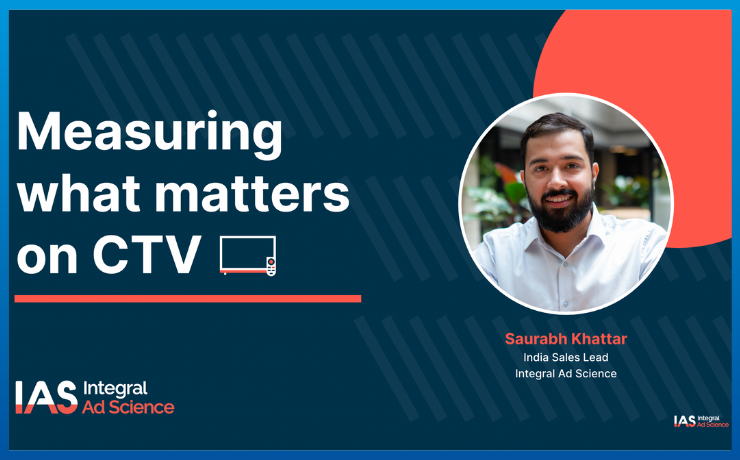
20 million – the number, by itself, is eye-catching; however, it is all the more impressive when we know that there are 20 million Connected TV (CTV) households in India. Roughly, this means there are 100 million customers. By 2025, India is estimated to have 80 million CTV households. In a day and age where brands are desperately trying to target customers, build a connection, and boost their brand image, CTV offers a platform like none other. For example, viewing on CTV is 2x longer compared to desktop & mobile. Despite these impressive numbers, CTV commands under 10% of overall ad spending and around 25% of the online video spending. Consumers spent significantly more time streaming content on CTV devices during stay-at-home guidance, which will only continue. This presents an opportunity for marketers to shift to a more efficient, data-driven approach to reaching audiences.
Before marketers jump at this exciting proposition, it is essential to understand how ad campaigns can be optimized for better efficiency and measurability so that marketers can continue to invest confidently.
Growing CTV Viewership Provides More Opportunities for Advertisers in 2022 and beyond
In India, the cable industry is losing about a million subscribers every month. In the quarter ending March 2022, the DTH operators lost 1.6 million subscribers, according to the Indian Telecom Services Performance Indicators report by the Telecom Regulatory Authority of India (TRAI). With so many subscription-based OTT services available to choose from, consumers are facing CTV subscription fatigue, giving rise to Advertising-based Video on Demand (AVOD). The consumer is less willing to shell out for streaming subscriptions; instead, they’re adopting ad-supported services that are available for free at a rapid pace.
A prime example of this is Netflix’s recent announcement of launching an ad-supported subscription tier that will charge advertisers a sky-high USD 65 as their CPM for every 1,000 views. This trend suggests that CTV, and particularly ad-supported streaming, will see unprecedented growth in the year ahead, with an expanding audience that is no longer reachable on cable TV.
CTV platforms provide a unique opportunity for consumers and advertisers alike. Consumers have the flexibility to choose content, and the provider, at their disposal. On the other hand, for advertisers, CTV provides an opportunity for better-targeted advertising and more engagement. With the boost in CTV viewership comes more ad inventory and significant brand opportunities. Marketers find the right way to connect with these audiences and use digital media quality solutions to understand their campaigns.
When it comes to advertising in any form, measurability is key; however, knowing what to measure becomes even more important. Let’s look at three key challenges when it comes to CTV advertising:
- CTV Ads Play When the TV is Off
A recently published study by GroupM revealed that 17% of impressions delivered through CTV streaming devices such as dongles, gaming consoles, and dongles/ sticks are delivered while televisions are off. This is observed in CTV devices or apps with their own power source, where the device might still be on when the TV is turned off, so ads play but are never seen on screen. Since viewability cannot be measured with conventional tracking methods on CTV, given the lack of VPAID support in this environment, this creates an added challenge.
At IAS, we have carefully thought of such challenges that advertisers face and developed a solution where we tailor viewability measurement to CTV by leveraging quartile completions. We even go a step further and perform extensive testing (for each Device/OS, App, Ad Length, and Beaconing Type), during which our engineering team validates:
- that ads constantly deliver with 100% of the pixels on the screen
- those ads cannot be skipped or fast-forwarded
- that ads stop playing when the TV screen is off
We only validate CTV apps for Rendered Impressions if they meet all these criteria, so you can be sure that if an impression is “Rendered” it has been actually seen. Impressions served to users who have stopped interacting with the CTV media content are no longer considered “Rendered.”
- Ad Fraud is High in CTV Campaigns
32% of agency/ marketing professionals consider ad fraud a leading challenge for CTV. Since the CTV environment is still new and growing in the advertising space, higher levels of ad fraud can be expected across less transparent and long-tail inventory.
As CTV consumers and ad spending continue to grow, we will see more and more tools to combat ad fraud. Currently, IAS is the first and only partner to work directly with the largest video publishers to validate that video ads are played to completion, free from invalid traffic, on CTV. Our close relationships with publishers allow us transparency into inventory so that we can properly identify signals that are known and unknown.
- CTV Ad Measurement is Critical for Driving Savings
CTV delivery costs can be as high as $40 CPM. When you compare that with the IAS rate for CTV standard measurement, i.e., $0.08 CPM, you notice that the verification costs are minuscule compared to overall spent, and more significantly compared to the savings that you could make by avoiding fraud, tv off wastage and potential brand safety breaches.
As CTV becomes even more mainstream this year, brands need to ensure a return on their investments. Always start with the data, measuring CTV inventory for viewability and completion rates to make sure campaigns are driving the expected impact.
The article was first published in Agency Reporter.
 Share on LinkedIn
Share on LinkedIn Share on X
Share on X

